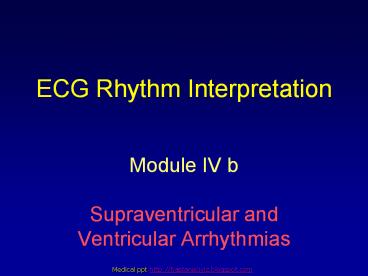ECG Rhythm Interpretation - PowerPoint PPT Presentation
Title:
ECG Rhythm Interpretation
Description:
ECG Rhythm Interpretation Module IV b Supraventricular and Ventricular Arrhythmias Medical ppt http://hastaneciyiz.blogspot.com Course Objectives To recognize the ... – PowerPoint PPT presentation
Number of Views:1208
Avg rating:3.0/5.0
Title: ECG Rhythm Interpretation
1
ECG Rhythm Interpretation
- Module IV bSupraventricular and Ventricular
Arrhythmias
Medical ppt
http//hastaneciyiz.blogspot.com
2
Course Objectives
- To recognize the normal rhythm of the heart -
Normal Sinus Rhythm. - To recognize the 13 most common rhythm
disturbances. - To recognize an acute myocardial infarction on a
12-lead ECG.
3
Learning Modules
- ECG Basics
- How to Analyze a Rhythm
- Normal Sinus Rhythm
- Heart Arrhythmias
- Diagnosing a Myocardial Infarction
- Advanced 12-Lead Interpretation
4
Arrhythmias
- Sinus Rhythms
- Premature Beats
- Supraventricular Arrhythmias
- Ventricular Arrhythmias
- AV Junctional Blocks
5
Supraventricular Arrhythmias
- Atrial Fibrillation
- Atrial Flutter
- Paroxysmal Supraventricular Tachycardia
6
Rhythm 5
100 bpm
- Rate?
- Regularity?
irregularly irregular
- P waves?
none
- PR interval?
none
- QRS duration?
0.06 s
Interpretation?
Atrial Fibrillation
7
Atrial Fibrillation
- Deviation from NSR
- No organized atrial depolarization, so no normal
P waves (impulses are not originating from the
sinus node). - Atrial activity is chaotic (resulting in an
irregularly irregular rate). - Common, affects 2-4, up to 5-10 if gt 80 years
old
8
Atrial Fibrillation
- Etiology Recent theories suggest that it is due
to multiple re-entrant wavelets conducted between
the R L atria. Either way, impulses are formed
in a totally unpredictable fashion. The AV node
allows some of the impulses to pass through at
variable intervals (so rhythm is irregularly
irregular).
9
Rhythm 6
70 bpm
- Rate?
- Regularity?
regular
- P waves?
flutter waves
- PR interval?
none
- QRS duration?
0.06 s
Interpretation?
Atrial Flutter
10
Atrial Flutter
- Deviation from NSR
- No P waves. Instead flutter waves (note
sawtooth pattern) are formed at a rate of 250 -
350 bpm. - Only some impulses conduct through the AV node
(usually every other impulse).
11
Atrial Flutter
- Etiology Reentrant pathway in the right atrium
with every 2nd, 3rd or 4th impulse generating a
QRS (others are blocked in the AV node as the
node repolarizes).
12
Rhythm 7
74 ?148 bpm
- Rate?
- Regularity?
Regular ? regular
- P waves?
Normal ? none
- PR interval?
0.16 s ? none
- QRS duration?
0.08 s
Interpretation?
Paroxysmal Supraventricular Tachycardia (PSVT)
13
PSVT
- Deviation from NSR
- The heart rate suddenly speeds up, often
triggered by a PAC (not seen here) and the P
waves are lost.
14
PSVT
- Etiology There are several types of PSVT but all
originate above the ventricles (therefore the QRS
is narrow). - Most common abnormal conduction in the AV node
(reentrant circuit looping in the AV node).
15
Ventricular Arrhythmias
- Ventricular Tachycardia
- Ventricular Fibrillation
16
Rhythm 8
160 bpm
- Rate?
- Regularity?
regular
- P waves?
none
- PR interval?
none
- QRS duration?
wide (gt 0.12 sec)
Interpretation?
Ventricular Tachycardia
17
Ventricular Tachycardia
- Deviation from NSR
- Impulse is originating in the ventricles (no P
waves, wide QRS).
18
Ventricular Tachycardia
- Etiology There is a re-entrant pathway looping
in a ventricle (most common cause). - Ventricular tachycardia can sometimes generate
enough cardiac output to produce a pulse at
other times no pulse can be felt.
19
Rhythm 9
none
- Rate?
- Regularity?
irregularly irreg.
- P waves?
none
- PR interval?
none
- QRS duration?
wide, if recognizable
Interpretation?
Ventricular Fibrillation
20
Ventricular Fibrillation
- Deviation from NSR
- Completely abnormal.
21
Ventricular Fibrillation
- Etiology The ventricular cells are excitable and
depolarizing randomly. - Rapid drop in cardiac output and death occurs if
not quickly reversed
22
End of Module IV bSupraventricular and
Ventricular Arrhythmias
- Proceed to Module IV b Practice Quiz on WebCT
Medical ppt
http//hastaneciyiz.blogspot.com































